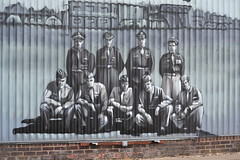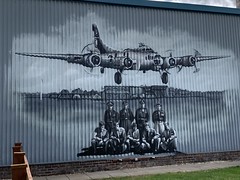There are many memorials and murals around the world dedicated to those who lost their lives or served on wartime airfields fighting the Nazi tyranny. In the UK these amount to hundreds if not thousands, and every now and again, one springs up and looks stunning.
At Conington, the former RAF Glatton, now a training airfield which utilises one of the three original runways, is one such mural, dedicated to those of the 457th Bomb Group who served with and flew missions from the airfield between February 21st, 1944, until April 20th, 1945.
Glatton airfield was built in the last months of 1942, by the 809th and 862nd Engineer Battalion (Aviation) of the U.S. Army, as a class ‘A’ airfield, and would be of a standard size and shape catering for some 3,000 men and women of mixed rank.
The only units to use the airfield were the four bomb squadrons: the 748th, 749th, 750th, and 751st Bomb Squadrons of the 457th Bomb Group, 94th Combat Bombardment Wing of the 1st Bombardment Division. Flying B-17s, they would take part in some of the most horrific battles of the air war, losing some 729 personnel as either killed, missing or taken prisoner, dropping just short of 17,000 tons of bombs in 237 missions.
After training at Rapid City Airfield in South Dakota, the 457th would enter the war with a real baptism of fire. On Monday 21st February 1944, the combined forces of the USAAF and the RAF were involved in the ‘Big Week‘ campaign. Officially known as Operation ‘Argument‘, it was designed to smash the German aircraft industry in one fell swoop. For an entire week the allies pounded the industrial regions of the Rhine, as one of the war’s biggest joint operations, it didn’t nevertheless prove to be as definitive as planned.
They would attack ball bearing plants, aircraft factories and oil refineries. Helped prepare the way for the invasion and took part in Mission 311, on April 22nd 1944, a mission that became famous for the operation in which US forces lost more aircraft to enemy intruders than at any other time in the war.
They would also attack coastal defences, railways, fuel depots took part in the attacks at St. Lo.
Many special visitors would also be seen at Glatton airfield, including in March 1944, YB-29 #41-36963 ‘Hobo Queen‘*8 which took off from Salina Airbase in Kansas piloted by Colonel Frank Cook, as part of a plan to ferry B-29s to China to bomb Japan from airfields there.
On April 20th 1945, the 457th flew their final operational mission, attacking the marshalling yards at Seddin, to the south of Berlin. With the end of the war just around the corner there was little resistance from either ground forces or the Luftwaffe, none of the 457th aircraft taking hits or suffering any damage, it was virtually a ‘milk run’.
Following VE day, the 457th flew POWs back from Europe to England, then with no further action to undertake, the airfield was handed back to the RAF’s No. 3 Group under the control of Bomber Command operating both the Avro Lancaster and Consolidated B-24 Liberators flying out to the Middle East.
By June the war for the 457th was over. The men and machines were transferred back to the United States with the aircraft leaving Glatton between May 19th and 23rd, and the ground echelons sailing on the Queen Elizabeth from Gourock in Scotland, at the end of June. After arriving at New York there was 30 days rest before the men assembled at Sioux Falls. Here the axe fell and the 457th was no more, the four squadrons being disbanded for good and the Group removed from the Air Forces inventory.
Glatton itself was eventually closed and the site was then sold off in 1948, mostly returning to agriculture.
Since then, a training company has taken over part of the airfield, T6 Harvard Ltd, a small light training company, have operated out of Glatton since 2021 providing flying training for pilots on a variety of aircraft including both Chipmunks and Harvard aircraft.
On the side of one of their buildings is a mural, painted by Nathan Murdock, a Peterborough artist, who created the design as a commission by the company owner Julie Churchill, and depicts a Lockheed/Vega B-17G-70-VE Fortress, #44-8557 of 748th Bombardment Squadron on its 234th mission, April 18, 1945. On board that day and depicted in the painting are: Roy Truba; Craig K Winters; Joseph Taylor; William Thistle; Luther Smith; Louis Domato; John H Taylor; John Miller and Harvey Henkel.
This crew was the last 457th crew to sustain a loss in the war when the aircraft was hit by flak over the marshalling yards in Freising on April 18th, two days before their last mission. Following the strike, the crew safely parachuted from the damaged plane, but Sgt. John T. Miller, the engineer, was killed. The rest of the crew landed safely but were soon captured and taken prisoner by the Germans. All were liberated by allied forces ten days later.
The mural was completed and then dedicated on August 19th, 2021 by the U.S. Air Force Col. Abe Jackson, EUCOM JAC commander, who said “Today symbolises an opportunity for us to recognise the significant contributions of those Airmen who came before us,”*1
The mural can be easily seen behind the clubhouse, which also has a display of photographs and memorabilia relating to the 457th and their time here at Glatton. It is a stunning piece of art work, not least of all becasue it is painted onto corregated metal, and is well worth a visit if you are in the area.

457th Bomb Group crew in 1945. Back row left to right: Roy Truba (Bombardier), Craig K Winters (Navigator), Joseph Taylor (Co-Pilot) and William Thistle (Pilot). Front row left to right: Luther Smith (Tail Gunner), Louis Domato (Radio Operator), John H Taylor (Ball Turret Gunner), John Miller (Flight Engineer) and Harvey Henkel (Right Waist Gunner). (Names taken from an original photo on the American Air Museum website).
Sources and further reading.
*1 501st Combat Support Wing Website
T6Harvard Ltd flying details can be found on their website.
The full history of Glatton can be read in Trail 6.
